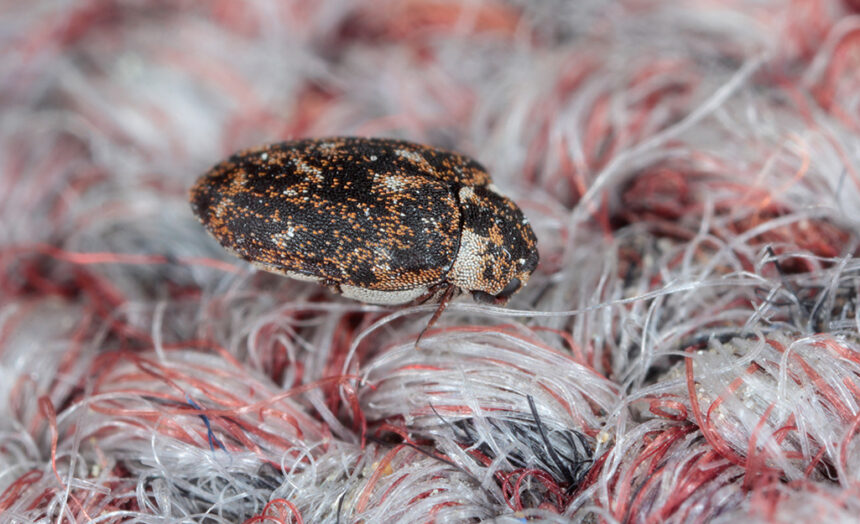Carpet beetles might be tiny, but their impact can be huge. If you’ve noticed mysterious holes in your clothing, damaged carpets, or little insects around your home, you could be dealing with these common pests. But don’t panic! This guide will walk you through everything you need to know about carpet beetles, from identifying them to preventing and getting rid of them effectively.
What Are Carpet Beetles and Why Are They a Concern?
Carpet beetles are small insects belonging to the family Dermestidae, often found in homes across the globe. While they can live outdoors in natural habitats, they frequently find their way inside houses, attracted to natural fibers and food debris.
Why are they a problem?
- Damage to Fabrics and Furniture: Carpet beetles are known for munching on natural materials like wool, silk, leather, and even stored food products.
- Allergic Reactions: Some people can experience skin irritation or allergic reactions caused by their tiny, hair-like bristles.
- Rapid Reproduction: Carpet beetles reproduce quickly, meaning a small problem can turn into a major infestation in no time.
Understanding why they’re a concern is the first step toward addressing the issue. Now, how do you recognize these little intruders?
How to Identify Carpet Beetles
What Do Carpet Beetles Look Like?
Carpet beetles come in different species, but most share the following key traits:
- Size: Adults are about 1/16 to 1/8 inch long.
- Shape: They’re small and oval-shaped.
- Color: Varies by species; some are black, while others have a distinctive mottled pattern of white, brown, and yellow scales.
Common Species of Carpet Beetles
- Varied Carpet Beetle (Anthrenus verbasci): Has a colorful, mottled appearance.
- Furniture Carpet Beetle (Anthrenus flavipes): Slightly larger with similar mottled patterns.
- Black Carpet Beetle (Attagenus unicolor): Completely black and slightly shiny.
Differentiating Carpet Beetles from Other Pests
Carpet beetles are often mistaken for other household pests, such as bed bugs or fleas. However:
- Unlike bed bugs, they don’t bite humans.
- Unlike fleas, they can’t jump.
- Larvae are often hairy or bristly, distinguishing them from smooth-bodied insects like grain beetles.
Spotting these pests early is crucial to tackling a potential infestation.
Signs of a Carpet Beetle Infestation
If you suspect carpet beetles are invading your home, look out for these tell-tale signs:
1. Holes in Fabrics
Damage to clothing, upholstery, or carpets is one of the most evident signs. Carpet beetle larvae feed on natural fibers, leaving irregular holes.
2. Shed Skins
As larvae grow, they shed their bristly skins, leaving small, hollow shells behind.
3. Sightings
Spotting adult carpet beetles near windows or light sources is quite common, as they’re drawn to light. The larvae are harder to notice but can often be found in dark, undisturbed areas.
4. Larvae Droppings
Inspect for tiny, coarse droppings (often referred to as “pellets”) near fabrics or infested items.
Noticing one or more of these signs means it’s time to act fast.
Preventing Carpet Beetles
“Prevention is better than cure,” especially when it comes to carpet beetles. Follow these steps to keep your home pest-free:
1. Regular Cleaning
- Vacuum carpets, rugs, and furniture regularly to remove lint, pet hair, and other food sources for carpet beetles. For a more thorough approach, consider professional services like carpet cleaning Los Angeles, which can help eliminate hidden pests and maintain a cleaner, healthier home environment.
- Wash clothing and bedding often, especially items stored for long periods.
2. Proper Storage
- Use airtight plastic containers or vacuum-sealed bags to store off-season clothing and linens.
- Avoid leaving food or crumbs exposed, particularly in pantries or cupboards.
3. Seal Cracks and Gaps
Inspect your doors, windows, and walls for gaps where beetles can enter. Caulking and weatherstripping are excellent solutions for sealing them.
4. Use Cedar or Mothballs
Cedarwood blocks or chips and mothballs naturally repel carpet beetles. Place them in storage areas for added protection.
Consistently applying these steps can help you steer clear of an infestation.
DIY Solutions to Manage Carpet Beetles
If you already have carpet beetles in your home, don’t worry! There are several DIY methods to address the problem:
1. Vacuum Everything
Thoroughly vacuum carpets, rugs, furniture, and even cracks in floorboards to remove beetles, larvae, and eggs.
2. Wash Infested Items
Clothing, linens, and other washable items should be laundered using hot water and detergent. Heat kills both adults and larvae.
3. Use Boric Acid
Sprinkle boric acid on carpets and upholstery, then vacuum it up after about two hours. It’s a safe and effective way to kill carpet beetles.
4. Essential Oils
Natural oils like eucalyptus or lavender are great for repelling carpet beetles. Mix a few drops with water and spray it on affected areas.
5. Set Traps
Sticky pheromone traps can catch adult beetles, preventing them from laying more eggs.
These methods are effective for small infestations but might not suffice if the problem is severe.
When Should You Call a Professional Exterminator?
There are situations where professional help is the best option:
- The infestation is widespread and recurring.
- DIY solutions aren’t yielding results.
- You’re unsure of where the beetles are coming from.
Professional pest control services use advanced tools and treatments to eliminate carpet beetles at all stages of their lifecycle. Plus, they can offer lasting prevention tips to stop them from coming back.
Take Control of Carpet Beetles for Good
Carpet beetles can be a nuisance, but with proper knowledge and action, you can protect your home and belongings. Here’s a quick recap:
- Spot carpet beetles early by identifying their key traits and signs of infestation.
- Prevent them through regular cleaning, proper storage, and sealing entry points.
- Tackle minor infestations with DIY solutions like vacuuming and boric acid.
- Call a professional if the problem persists or becomes overwhelming.
Have a carpet beetle issue you’re unsure about or need professional advice? Get in touch with a local pest control expert to safeguard your living space today.


